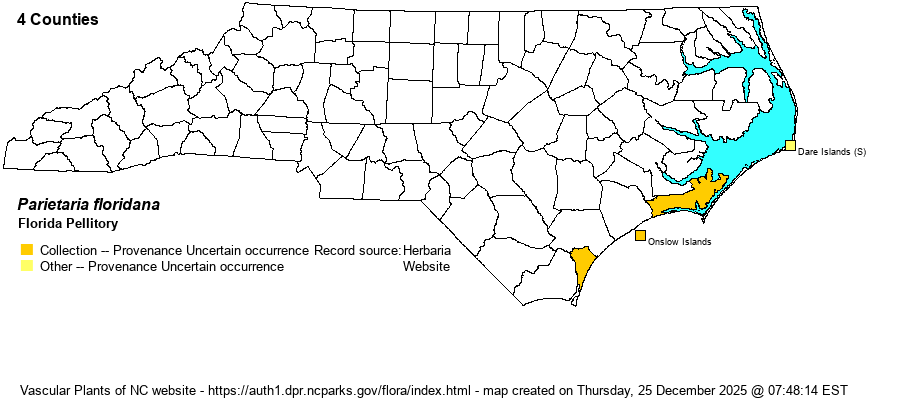| Author | Nuttall | |
| Distribution | Coastal or near-coastal, north to Cape Hatteras (Dare County). The only confirmed record is a specimen from the riverfront in Wilmington, New Hanover County (Nelson 15514 et al. NCSC, USCH, WILLI). SERNEC specimens are also from Morehead City on mainland Carteret County and in coastal Onslow County. There are Research Grade photos for the Cape Hatteras area of coastal Dare County. Easily confused with P. praetermissa. Weakley (2018) considers it as native in NC, though the NCNHP is not as sure. The editors feel that it is likely not native, if the only confirmed record is from a city waterfront, where many exotic/naturalized species are found. The specimen and other sight records for mainlnad Carteret are also on cracks in pavement or other man-made places. In 2022 Sorrie checked the ID of all P. floridana and praetermissa at NCU and those with images online at SERNEC.
This species ranges from eastern NC south to nearly all of FL, and west scattered to southern TX. The global range is confused with the very similar P. praetermissa, and the NC range is also likely confused as well.
| |
| Abundance | Rare and local near the coast. The NCNHP has it on its Watch List, but as W4 -- perhaps not native. Their revised State Rank is SU (Undetermined), owing to its unsettled provenance in the state. The website editors prefer a State Rank of SE? to indicate a likely non-native taxon. | |
| Habitat | Over most of its range, this species typically has similar habitats to the very similar P. praetermissa. However, that species seems to occur mainly in natural settings in NC -- shell middens and margins and openings in hammocks, and on barrier islands, but it can occur in cracks in pavement and other disturbed habitats. On the other hand, most originally identified P. floridana records in the state are in disturbed coastal habitats. Some records are for lawns, cracks in pavement, "sandy alley edges", and other obviously weedy and ruderal sites. It can occur on shell middens and around hammock margins elsewhere in the range, but no records in NC are from such natural settings. Note that Sorrie now believes that all such "floridana" reports from outside of Wilmington now refer to P. praetermissa. | |
| Phenology | Blooms from March to frost, and fruits from April to frost. | |
| Identification | This species and P. praetermissa are very closely related, likely included as a single species in many references, though Weakley (2018) treats them as separate species. Each is a very small plant, with several basal branches, and appearing mostly decumbent or sprawling, reaching only about 2-4 inches tall. The leaves are alternate, with small ovate and entire blades that have tapering tips and a "long" petiole, though that is often just 1/4-inch long. Both have tiny flowers in clusters in leaf axils. In this species, the leaf blades are only 0.7-2.7 cm long -- barely 1-inch long at most and often about 1/2-inch long or less. P. praetermissa has leaves roughly 1-6.5 cm long -- 1.5-2 inches long. Weakley (2018) also says that this species has "Achene 0.6-0.9 mm long, with a flanged stipe, the mucro located symmetrical at the pole of the achene", versus "Achene 1.0-1.4 mm long, without a flanged stipe, the mucro located asymmetrically" in P. praetermissa. Obviously, it is the leaf blade size that will be the most obvious separation character for these two species. | |
| Taxonomic Comments | This species and P. praetermissa are often confused in the literature, and some SERNEC specimens in NC might not be correctly identified, as a result. Most current references have them as separate species.
| |
| Other Common Name(s) | None | |
| State Rank | SU [SE?] | |
| Global Rank | G5 | |
| State Status | W4 | |
| US Status | | |
| USACE-agcp | FAC link |
| USACE-emp | FAC link |

